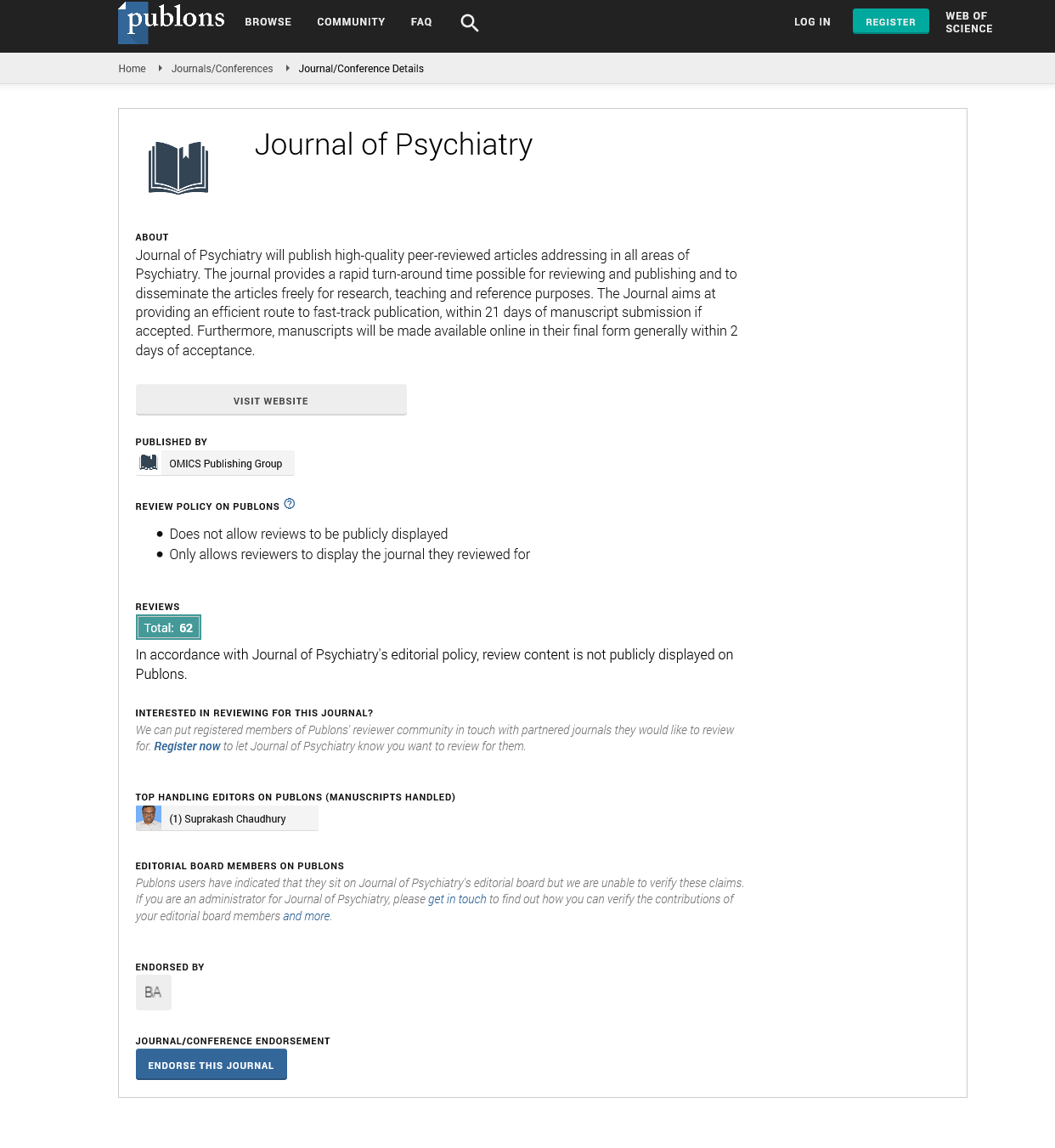Indexed In
- RefSeek
- Hamdard University
- EBSCO A-Z
- OCLC- WorldCat
- SWB online catalog
- Publons
- International committee of medical journals editors (ICMJE)
- Geneva Foundation for Medical Education and Research
Useful Links
Share This Page
Open Access Journals
- Agri and Aquaculture
- Biochemistry
- Bioinformatics & Systems Biology
- Business & Management
- Chemistry
- Clinical Sciences
- Engineering
- Food & Nutrition
- General Science
- Genetics & Molecular Biology
- Immunology & Microbiology
- Medical Sciences
- Neuroscience & Psychology
- Nursing & Health Care
- Pharmaceutical Sciences
Short Communication - (2025) Volume 28, Issue 2
Virtual Realities, Real Emotions: Immersive Technologies in Psychiatric Treatment
Sophia Weber*Received: 24-Feb-2025, Manuscript No. JOP-25-28820; Editor assigned: 26-Feb-2025, Pre QC No. JOP-25-28820; Reviewed: 12-Mar-2025, QC No. JOP-25-28820; Revised: 18-Mar-2025, Manuscript No. JOP-25-28820; Published: 26-Mar-2025, DOI: 10.35248/2167-0358.25.28.735
Description
In recent years, the field of psychiatric treatment has seen remarkable innovations, especially with the advent of immersive technologies such as Virtual Reality (VR) and Augmented Reality (AR). These technologies, once thought to be solely the domain of entertainment, have begun to find applications in therapeutic settings, offering new ways to address various mental health conditions. With their ability to create fully immersive experiences, these tools offer a unique opportunity to simulate real-world situations and environments, making them useful in helping individuals navigate challenges related to anxiety, depression, phobias and even Post Traumatic Stress Disorder (PTSD). One of the most promising applications of VR in psychiatric treatment is its use in exposure therapy. Exposure therapy is a well-established psychological treatment method that involves the controlled, gradual exposure of individuals to stimuli that trigger fear or anxiety, allowing them to process their reactions in a safe and supportive environment. Traditionally, this type of therapy could be difficult to carry out because of the logistical challenges of recreating certain situations. With VR, however, therapists can create immersive scenarios that closely resemble real-life situations, enabling patients to confront their fears in a controlled, virtual space. For example, individuals with social anxiety can practice public speaking in front of a virtual audience, or those with a fear of flying can experience a simulated flight, all while remaining in a therapeutic environment where they are supported by professionals.
In addition to anxiety and phobia treatments, VR is also being explored as a tool for managing PTSD. Veterans and others affected by trauma often find it difficult to process memories of distressing events. By recreating controlled versions of traumatic scenarios in a virtual setting, individuals can be gently guided through their memories, helping them confront the emotions attached to these experiences. This exposure, when done with care, can help reduce the emotional charge of traumatic memories over time, promoting healing and offering an alternative to traditional methods that may not be as effective for every individual. Beyond treating anxiety and PTSD, VR has also found applications in treating mood disorders like depression. In some cases, VR experiences are used to help patients break free from negative thought patterns. One therapeutic approach involves using VR to place individuals in calming, nature-based environments. These virtual spaces can offer patients a temporary escape from the stress and demands of everyday life, promoting relaxation and mindfulness. For those suffering from depression, VR can serve as a tool to practice emotional regulation skills by engaging with the calming effects of immersive environments. In other cases, VR can help individuals gain a sense of accomplishment and purpose by offering them tasks and challenges that are both engaging and rewarding.
Furthermore, VR's potential to replicate real-world scenarios is particularly valuable when treating individuals with conditions that involve social difficulties, such as Autism Spectrum Disorder (ASD). People with ASD often struggle with social interactions and understanding non-verbal cues. Using VR, therapists can create social simulations that allow patients to practice interacting with virtual characters. These interactions provide a safe space for individuals to refine their social skills without the pressure or anxiety that might arise from real-world encounters. This technique has shown promise in improving communication skills and helping individuals with ASD navigate social situations more effectively. In summary, immersive technologies like VR and AR offer exciting new possibilities for treating a variety of mental health conditions. Whether it's helping individuals confront their fears through exposure therapy, providing relaxation and mindfulness techniques for those with depression, or offering safe social simulations for those with ASD, these technologies have the potential to enhance psychiatric care in innovative ways. While there are challenges to overcome, such as accessibility and the need for careful program design, the integration of immersive technologies into mental health treatment is an exciting step forward. As research in this field continues to grow, it is likely that immersive technologies will play an increasingly important role in how psychiatric conditions are understood and treated.
Citation: Weber S (2025) Virtual Realities, Real Emotions: Immersive Technologies in Psychiatric Treatment. J Psychiatry. 28:735.
Copyright: © 2025 Weber S. This is an open-access article distributed under the terms of the Creative Commons Attribution License, which permits unrestricted use, distribution and reproduction in any medium, provided the original author and source are credited.

